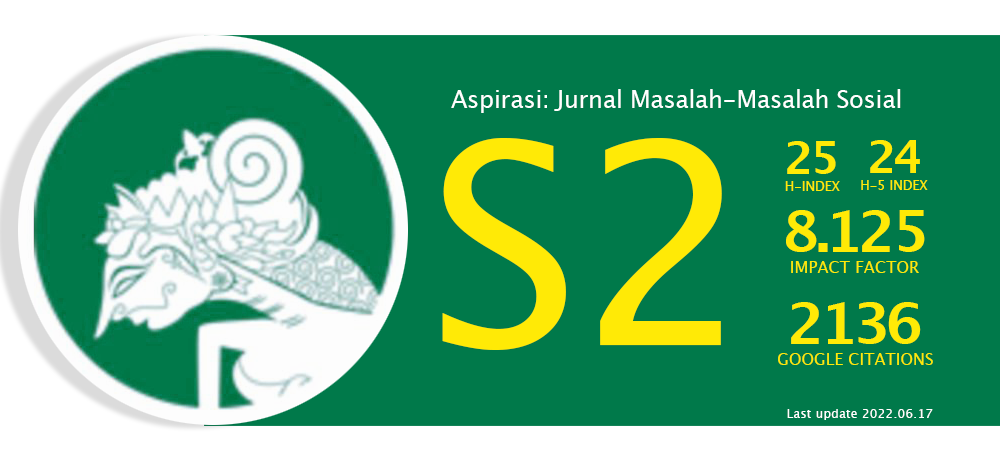Penanggulangan Kemiskinan Perempuan melalui Strategi Keuangan Inklusif oleh Koperasi Mitra Dhuafa (KOMIDA)
Abstract
Poverty is still relatively high, especially among women. On the one hand the gap in work participation between men and women still occurs. On the other hand women have the opportunity to overcome the problems of poverty and their families with flexible work and do not interfere with the task of taking care of the household. Entrepreneurship is the right choice but needs to be accompanied by inclusive finance that brings capital closer to women. Inclusive finance is characterized by access to business capital financing without collateral, one-stop financial transactions, availability of financing that exceeds demand and increased financial literacy including saving habits and increasing financial management capabilities. It aims to describe and analyze the application of inclusive financial strategies in sustainable poverty reduction for women and to explain and analyze the impact of poverty reduction on low-income women and their families. The research method used is a qualitative approach with a descriptive type. The results show that financing can increase business interest and stimulate business development, increase income and strengthen the role of women in the welfare of their families. Poverty alleviation through an inclusive financial strategy is effective in increasing the economy, capacity and role of women in the welfare of the family. An adequate selection and monitoring system has a profound effect on this success.
Abstrak
Kemiskinan masih tergolong tinggi, khususnya di kalangan perempuan. Sementara kesenjangan partisipasi kerja antara laki-laki dan perempuan masih terjadi. Di sisi lain perempuan memiliki peluang untuk mengatasi masalah kemiskinannya dan keluarganya dengan pekerjaan yang fleksibel dan tidak mengganggu tugas mengurus rumah tangga. Berwirausaha adalah pilihan yang tepat, namun perlu diiringi dengan keuangan inklusif yang mendekatkan modal kepada perempuan. Keuangan inklusif ditandai dengan akses terhadap pembiayaan modal usaha tanpa agunan, transaksi keuangan satu pintu, ketersediaan pembiayaan yang melebihi permintaan, dan peningkatan literasi keuangan, meliputi kebiasaan menabung serta peningkatan kemampuan pengelolaan keuangan. Penelitian ini bertujuan menguraikan dan menganalisis penerapan strategi keuangan inklusif dalam penanggulangan kemiskinan perempuan serta dampaknya terhadap perempuan berpendapatan rendah dan keluarganya. Metode penelitian yang digunakan adalah pendekatan kualitatif dengan jenis deskriptif. Hasil menunjukkan bahwa pembiayaan mampu meningkatkan minat usaha dan memberi stimulan dalam pengembangan usaha, peningkatan pendapatan, serta memperkuat peran perempuan dalam menyejahterakan keluarganya. Penanggulangan kemiskinan melalui strategi keuangan inklusif efektif meningkatkan ekonomi, kapasitas dan peran perempuan dalam menyejahterakan keluarga. Sistem seleksi dan monitoring yang memadai sangat besar pengaruhnya akan keberhasilan ini.
Keywords
Full Text:
pdfReferences
Abdulkadir, M. & Rilda, M. (2000). Lembaga Keuangan dan Pembiayaan. Bandung: PT Citra Aditya Bakti.
Adams, G. A. & Rau, B. L. (2011). Putting off tomorrow to do what you want today: planning for retirement. American Psychologist, 66(3), 180.
Badan Pusat Statistik. (2018). Persentase Pendu- duk Yang Hidup di Bawah Garis Kemiskinan Nasional, Menurut Jenis Kelamin 2015– 2018. Retrieved from https://www.bps. go.id/dynamictable/2019/10/04/1653/ persentase-penduduk-yang-hidup-di-bawah- garis-kemiskinan-nasional-menurut-jenis- kelamin-2015-2018.html, on April 30, 2020.
Bank Indonesia. Kamus. Retrieved from https://www. bi.go.id/id/Kamus.aspx, on September 1, 2019.
Bhatia, S. & Singh, S. (2019). Empowering Women Through Financial Inclusion: A Study Of Urban Slum. The Journal for Decision Makers, 44(4), 182–197. Retrieved from https://remote-lib.ui.ac. id:2158/doi/pdf/10.1177/0256090919897809, on April 20, 2020.
Boon, T. H., Yee, H. S., & Ting, H. W. (2011). Financial literacy and personal financial planning in Klang Valley, Malaysia. International Journal of Economics and Management, 5(1), 149–168.
Bullock, H. E. (2013). Woman and Poverty: Psychology, Public Policy, and Social Justice. West Sussex: Wiley Blackwell.
Carpena, F., Cole, S., Shapiro, J., & Zia, B. (2011). Unpacking the causal chain of financial literacy. Policy Research working paper; no. WPS 5798. Washington, DC: World Bank. Retrieved from http://documents.worldbank.org/curated/ en/329301468322465624/Unpacking-the- causal-chain-of-financial-literacy, on April 30, 2020.
Cohen, E. (1984). The sociology of tourism: approaches, issues, and findings. Annual review of sociology, 10(1), 373–392.
Goldberg, M. & Palladini, E. (2010). Managing Risk and Creating Value With Microfinance. Washington DC: World Bank.
Ife, J. (2013). Community development in an uncertain world: vision, analysis and practice. New York: Cambridge University Press.
Jiang, L., Tong, A., Hu, Z., & Wang, Y. (2019). The Impact of Inclusive Financial Development Index on Farmer Entrepreneurship. Journal Plos One, 14(5): e0216466. doi: 10.1371/journal. pone.0216466.
Kementerian Keuangan. (2012). Press Release KementerianKeuanganHasilKTTG-20.Retrieved from https://fiskal.kemenkeu.go.id/dw-konten- view.asp?id=20120622083024508899900, on April 30, 2020.
Kodan, A S. & Chhikara, K S A. (2013). Theoretical and Quantitative analysis of Financial Inclusion and Economic Growth. Management and Labour Studies, 38(1–2), 103–133. Jamshedpur: School of Business Management & Human Resources. Retrieved from https://remote-lib.ui.ac.id:2158/ doi/pdf/10.1177/0258042X13498009, on April 30, 2020.
Lusardi, A. & Mitchelli, O. S. (2007). Financial literacy and retirement preparedness: Evidence and implications for financial education. Business economics, 42(1), 35–44.
Lusardi, A. & Mitchell, O. S. (2014). The Economic Importance of Financial Literacy: Theory and Evidence. Journal of Economic Literature, 52(1), 5–44. doi: 10.1257/jel.52.1.5.
Mainsah, E., Heuer, S. R., Kalra, A., & Zhang, Q. (2004). Grameen Bank: Taking capitalism to the poor. Chazen Web Journal of International Business, 1–28.
Mishra, A., Igwe, P., Lean, J., & Megicks, P. (2014). Supporting micro and small enterprises. In The Routledge Companion to Financial Services Marketing. London: Routledge (Taylor & Francis Group).
Moleong, L. (2005). Metodologi Penelitian Kualitatif untuk Ilmu-Ilmu Sosial. Bandung: PT. Remaja Rosdakarya.
Neuman, W. L. (2016). Metodologi Penelitian Sosial: Pendekatan Kualitatif dan Kuantitatif. Jakarta: PT Indeks.
Peraturan Presiden tentang Strategi Nasional Keuangan Inklusif (2016).
Pemerintah Kecamatan Cileungsi. (2015). Profil Kecamatan Cileungsi. Retrieved from http:// kecamatancileungsi.bogorkab.go.id, on August 29, 2019.
Sarma, M. (2012). Index of Financial Inclusion - A measure of financial sector inclusiveness. Berlin Working Paper No.07/2012 on Money, Trade, Finance, and Development. Berlin: Competence Center “Money, Finance, Trade and Deve- lopment”. Retrieved from https://finance-and- trade.htw-berlin.de/fileadmin/HTW/Forschung/Money_Finance_Trade_Development/working_ paper_series/wp_07_2012_Sarma_Index-of- Financial-Inclusion.pdf, on August 29, 2019.
Sinaga, S. (2004). Dampak Sosial Kebijakan Pemda DKI Jakarta Tentang Relokasi Pedagang Kaki Lima di Lokasi Binaan Studi Kasus di Lokasi Binaan Paal Merah Jakarta Pusat. Jakarta: Universitas Indonesia.
Soelaksono, B. (2005). Keuangan Mikro di Indonesia. Lembaga Penelitian SMERU. No.13, 3–10. Retrieved from http://www.smeru.or.id/sites/ default/files/publication/news13.pdf, on August 29, 2019.
Stynes, D. J. (1997). Recreation Activity and Tourism Spending in the Lake States. St.Paul, MN: North Central Forest Experiment Station.
Suharto, E. (2009). Membangun Masyarakat Memberdayakan Masyarakat. Bandung: PT Refika Aditama.
Tim Publikasi Katadata. (2019). Tingkat Partisipasi Angkatan Kerja Perempuan Indonesia Rendah Dibanding Negara ASEAN. Retrieved from https://databoks.katadata.co.id/datapublish /2019/05/09/tingkat-partisipasi-angkatan-kerja- perempuan-indonesia-rendah-dibanding-negara- asean, on August 29, 2019.
Todaro, M P. (2000). Pembangunan Ekonomi di Dunia Ketiga. Jakarta: Erlangga.
Yaumidin, U K., Suhodo, D S., Yuniarti, P I., & Hidayatina, A. (2017). Financial Inclusion for Woman: Impact Evaluation on Islamic Microfinance to Women Empowerment in Indonesia. Financial Inclusion and Poverty Alleviation, 81–140. Retrieved from https:// remote-lib.ui.ac.id:2069/content/pdf/10.1007 %2F978-3-319-69799-4_3.pdf, on August 29, 2019.
DOI: https://doi.org/10.46807/aspirasi.v11i1.1501
Refbacks
- There are currently no refbacks.







